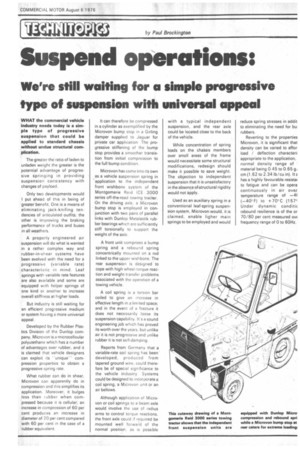Suspend operations:
Page 47

If you've noticed an error in this article please click here to report it so we can fix it.
We're still waiting for a simple progressive type of suspension with universal appeal
WHAT the commercial vehicle industry needs today is a simple type of progressive suspension that could be applied to standard chassis without undue structural complication.
The greater the ratio of laden to unladen weight the greater is the potential advantage of progressive springing in providing suspension consistency with changes of payload.
Only two developments would I put ahead of this in being of greater benefit. One is a means of eliminating jack-knifing tendencies of articulated outfits; the other is improving the braking performance of trucks and buses in all weathers.
A properly engineered air suspension will do what is wanted in a rather complex way and rubber-in-shear systems have been evolved with the need for a progressive (variable rate) characteristic in mind. Leaf springs with variable rate features are also available and some are equipped with helper springs of one kind or another to increase overall stiffness at higher loads.
But industry is still waiting for an efficient progressive medium or system having a more universal appeal.
Developed by the Rubber Plastics Division of the Dunlop company, Microvon is a microcelloular polyutethane which has a number of advantages over rubber, and it is claimed that vehicle designers can exploit its "unique" compression properties to obtain a progressive spring rate.
What rubber can do in shear, Microvon can apparently do in compression and this simplifies its application. Moreover, it bulges less than rubber when compressed because it is cellular; an increase in compression of 60 per cent produces an increase in diameter of 20 per cent compared with 60 per cent in the case of a rubber equivalent. It can therefore be compressed in a cylinder as exemplified by the Microvon bump stop in a Girling damper supplied to Jaguar for private car application The progressive stiffening of the bump stop provides a smoother transistion from initial compression to the full bump condition.
Microvon has come into its own as a vehicle suspension spring in "application to the independent front wishbone system of the Montgornerie Reid ICE 3000 series off-the-road towing tractor. On the driving axe, a Microvon bump stop is employed in conjunction with two pairs of parallel links with Dunlop Metalastik rubber bearings which are sufficiently stiff torsionally to support the weight of the axle.
A front unit comprises a bump spring and a rebound spring concentrically mounted on a rod linked to the upper wishbone. The rear suspension is designed to cope with high wheel-torque reaction and weight-transfer problems associated with the operation of a towing vehicle.
A coil spring is a torsion bar coiled to give an increase in effective length in a limited space; and in the event of a fracture it does not necessarily loose its suspension capability. Its s a sound engineering job which has proved its worth over the years, but unlike air it is not progressive and unlike rubber it is not self-damping.
Reports from Germany that a variable-rate coil spring has been developed, produced from tapered ground wire, could therefore be of special significance to the vehicle industry. Systems could be designed to incorporate a coil spring, a Microvon unit or an air bellows.
Although application of Microvon or coil springs to a beam axle would involve the use of radius arms tocontrol torque reactions, the front axle could if required be mounted well forward of the normal position. as is possible with a typical independent suspension, and the rear axle could be located close to the back of the vehidle.
While concentration of spring loads on the chaSsis members over small areas of the frame would necessitate some structural modifications, redesign should make it possible to save weight. The objection to independent suspension that it is unsatisfactory in the absence of-structural rigidity would not apply.
Used as an auxiliary spring in a conventional leaf-spring suspension system, Microvon would, it is claimed, enable ligher main springs to be employed and would reduce spring stresses in addit to eliminating the need for bui rubbers.
Reverting to the properties Microvon, it is significant that density can be varied to affor: load / deflection characteri: appropriate to the application, normal density range of • material being 0.45 to 0.65 g cm (1.62 to 2.34 lb/cu in). It a has a highly favourable-resistai to fatigue and can be opera continuously in air over temperature range of —4( (-40° F) to +70°C (157"' Under dynamic conditic rebound resilience is of the or 70/80 per cent measured ovE frequency range of 0 to 60Hz.




















































































